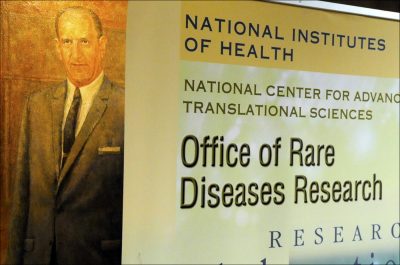NIH Agency Pioneers Collaborative Research into Rare Diseases
Written by |

Office of Rare Diseases Research at NCATS in Bethesda, Maryland. (Photo by Larry Luxner)
A little-known government entity within the National Institutes of Health (NIH) is helping to lead U.S. efforts to speed up the development of therapies for some 7,000 rare diseases.
The Office of Rare Diseases Research (ORDR), headquartered in Bethesda, Maryland, was established in 1993 within the NIH Office of the Director. In 2011, it became part of the NIH’s National Center for Advancing Translational Sciences (NCATS), which supports a variety of research programs and initiatives for rare diseases.
Anne Pariser, MD, director of the ORDR, said her agency’s mission is to facilitate coordination among scientists, clinicians and advocacy groups, while “accelerating rare diseases research to benefit patients.”
Pariser helped put together the recent Rare Disease Day 2018 event, which brought about 600 people into the NIH Clinical Center and was followed by 1,400 viewers online. She spoke to Bionews Services — publisher of this website — following the March 1 gathering.
“We’re trying to emphasize that, taken together, rare diseases are not rare at all,” Pariser said, estimating that 30 million Americans — or one-tenth of the U.S. population — have diseases which are considered rare. “Most of these diseases are serious and life-threatening — and half our patients are children. So there’s a real urgency to help our patients.”
Pariser said her unit employs eight people and operates on an annual budget of $18 million (a tiny fraction of the $3.5 billion NIH has budgeted for rare disease research in 2018). Most of that money — about $15 million — goes to the Rare Diseases Clinical Research Network (RDCRN), with the remainder funding mainly the Genetic and Rare Diseases Information Center.
Now in its third five-year award cycle, RDCRN encompasses 21 consortia working on 197 rare diseases through 454 clinical centers in the United States and 20 other countries. Its trials involve more than 45,000 participants.
“The purpose of the RDCRN is to support collaborative research, because there are so many rare diseases that we can’t do one disease at a time,” Pariser said. “It’s more efficient and there’s greater opportunity for collaboration, data sharing and best practices development if we use coordinated approaches.”
To qualify, two or more studies are required, one of which must be observational, such as a registry or natural history study. In addition, the primary clinical site must be on U.S. territory.
“Those applying to become an RDCRN consortium must propose a therapeutic area clustering three or more diseases or conditions,” she said. “For example, the Lysosomal Disease Network includes 70 different diseases, all with a unifying theme. We also have the Rare Lung Disease Consortium, which revolves around several different lung diseases.”
Other consortia include brittle bone disorders, mitochondrial diseases, vasculitis, nephrotic syndrome, eosinophilic gastrointestinal diseases, and urea cycle disorders.
From rare to rather common
“Many of these diseases are hard to diagnose, and they’re not well-understood. Most diseases don’t have ongoing research, so that together makes it harder to start moving a research program and therapeutic development forward,” Pariser said, adding that “the research and the insight you gain from rare diseases actually helps common diseases, too.”
“All of the breakthroughs” in understanding and treating high cholesterol — a rather widespread health problem — came through work into a “one-in-a-million severe familial disorder,” she said. That very rare disease, homozygous familial hypercholesterolemia, affects a person’s ability to manage cholesterol.
Pariser, who’s originally from Canada, studied at Georgetown Medical School and spent 16 years at the U.S. Food and Drug Administration (FDA) — first as a medical officer, then a team leader at the agency’s Center for Drug Evaluation and Research (CDER), reviewing rare disease applications. In 2010, she established CDER’s Rare Diseases Program.
“The FDA has shown tremendous willingness to work with researchers and drug developers to consider non-traditional clinical trial designs,” she said. “Most of the time, for rare diseases, a single efficacy trial will be accepted rather than the usual two or more, because there isn’t a lot of precedent with each rare disease. There’s also a lot of flexibility in identifying endpoints.”
A ‘toolkit’ for patient groups
The RDCRN’s current five-year funding cycle ends in mid-2019; the agency will soon solicit proposals for its fourth cycle, which will expire in 2023. Meanwhile, NCATS recently launched a new project: the “NCATS Toolkit for Patient-Focused Therapy Development.”
A comprehensive online resource, this toolkit is targeted to patient groups. It aims to “engage patients as essential partners in research and development” by giving such groups the tools they need to develop and advance their medical research agendas.
The toolkit — developed with input from groups like the Parent Project Muscular Dystrophy and the Friedreich’s Ataxia Research Alliance — is divided into four topics: discovery, preparing for clinical trials, clinical trials and FDA review, and after FDA review.
While NCATS developed this resource to facilitate therapeutics research and development, many of the tools are not specific to rare diseases and may also be useful to patient advocacy groups for common diseases and conditions.








